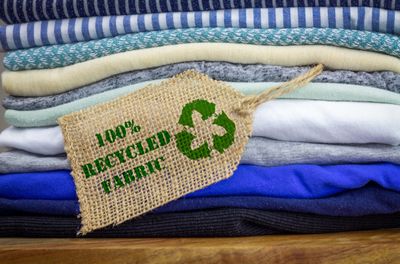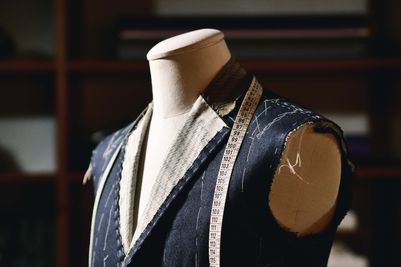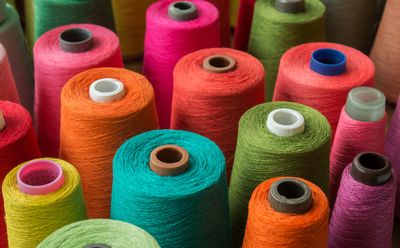Reconomy Group company Valpak collaboration with textiles retailers provides an analysis of recycling potential in the UK
Published:
Read Time: 6 mins
Reconomy Group company Valpak has published an analysis of textiles data to help retailers understand the scale of opportunity for textile reuse and recycling, and to show how recycling can complement reuse in the development of a circular economy for textiles.
The report – From Waste to Worth: An Analysis of Textile Recycling Opportunity in the UK – analysed data from six UK textiles retailers, as well as consulting brands, sorters and recyclers. The data was used to determine breakdown of materials, and suitability for mechanical and chemical recycling, with additional analysis on reusability.
Steve Gough, CEO at Valpak, said: “Sustainable textiles management is rising swiftly up the agenda, with legislation and consumer demand bringing it into focus. Valpak already manages textiles compliance for businesses operating in France, and the rest of the EU is likely to follow suit with its own textile legislation in the next 12 months.
“For the textiles report, we have used a similar methodology and approach to Valpak's previous PackFlow reports, which determine the flow of packaging onto the market and the various packaging recycling routes. As with all of these reports, they use best available information and analysis, so we are always happy to hear from interested parties who have further information. While only representing a relatively small sample, Valpak’s textiles report shows a clear pattern – textile products made from single fibres offer significantly greater opportunity for recycling.
“It is also worth mentioning that while businesses pursue the holy grail – closed-loop recycling – established open-loop systems already successfully process textiles into usable products. A combination of reuse, closed and open-loop is likely to emerge as the most effective solution.”
Report findings:
The importance of material specification
The prevalence of materials varied depending on textiles categories. The dominant material in the clothing category, for example, was cotton (57 per cent), followed by polyester (24 per cent). However, large variations were found between men, women’s and children’s clothing. The report also analysed footwear, accessories and household textiles.
60 per cent of total material was found to be recyclable using a combination of chemical recycling and open-loop mechanical recycling, or 53 per cent of total material using a combination of chemical recycling and closed-loop mechanical recycling (where feedstock is mono-fibre for both types of mechanical recycling).
Open-loop mechanical recycling shreds textiles for use in applications such as insulation, filling of car seats, or industrial wipes. Fibre-to-fibre, or closed-loop systems, recycle fibre back into new fibre. Chemical recycling is able to separate some blends, which mechanical fibre-to-fibre recycling typically does not.
Fifty-three per cent of material was found to be open-loop mechanically recyclable. This is based on the assumption that only mono-fibre material is open-loop mechanically recyclable, however. Extending the scope to include polycotton blends increased recyclability to 68 per cent.
Fibre-to-fibre
A 2022 report by McKinsey* estimates that currently less than 1 per cent of textile waste is fibre-to-fibre recycled. While technologies are developing rapidly, issues around collection, sorting, and pre-processing capacity currently limit the potential for fibre-to-fibre.
The Valpak study showed that the sorting process will be essential in achieving high recycling rates. If we are to build a circular textiles economy, significant investment in effective sorting infrastructure is needed.
A total of 46 per cent of material was closed-loop (fibre-to-fibre) mechanically recyclable, while 28 per cent of products were found to be chemically recyclable (if using a chemical recycling feedstock specification of 95 per cent or more cotton content).
Reuse
The overriding consensus from stakeholders was that textile products should adhere to the waste hierarchy – reuse should be prioritised over recycling, and reduction should take precedence over reuse.
Thirty-three per cent of the material analysed was considered to have a low likelihood of reusability; 42 per cent a medium level of reusability, and 26 per cent a high level of reusability. Bed sets and towels were among those items with a high level of recyclability and low likelihood of reusability, making them an ideal target material for recycling.
Gough concluded: “This study is based on the best available data, and outputs should be considered as indicative, with the potential to expand the scope of the study to increase robustness. Valpak would like to invite any stakeholders who have any data or insight that could be valuable to a potential second phase of this project to approach Valpak to discuss collaboration.”
To download the report in full, visit: https://www.valpak.co.uk/knowledge-hub-post/textileflow-from-waste-to-worth/
Ends
Editors notes
· Valpak’s report involved stakeholders across the textiles supply chain. Retailers included a supermarket, multiple UK-wide high-street and online retailers, and a home furnishings retailer.
· The study is based on the best available data, and outputs should be considered as indicative, with the potential to expand the scope of the study to increase robustness. Based on tonnage, the data used in this study before scaling up represents 11% of the UK clothing market, 6% of the UK footwear and accessories market, and 2% of the UK household textiles market from across a range of retailer and product types. POM data has been obtained by scaling up datasets from a variety of textile retailers based on their tonnage, to be reflective of the total UK market.
· It must be noted that although feedstock specifications for chemical or mechanical recycling are being applied to determine technical recyclability of total textiles POM, this is not a statement that such quantities are capable of being processed currently (as this would be prevented by capacity limitations and lack of commercial scalability, as well as by the fragmented nature of available feedstock arisings) or that the technology could be scaled to this extent (issues around the scaling of these technologies, particularly regarding chemical recycling, are discussed within this report).
· Communication with textile sorters highlighted a variety of potential issues around fibre-to-fibre recycling (particularly chemical) that should be considered when reviewing the output of this report. These included:
o Lack of verified scalability / commercial viability, and no guarantee of whether this will come.
o Some fibre-to-fibre recyclers’ feedstock specifications (notably mono-fibre white cotton) being material that currently has a viable open-loop end-of-life route: industrial wiping rags (however it should be noted that this is not a circular solution).
o The energy and chemicals required in chemical recycling.
· Valpak’s mission is to create a sustainable, waste-free world. We are driven, not by today. We are driven by tomorrow.
· We help our clients to reduce waste and recycle more, continually innovating and using leading data science and expertise to inspire businesses, help push ourselves – and our industry – forward. We don’t just show our customers how to navigate waste regulations; we help them become more sustainable, through our ever-increasing capabilities and pioneering innovations.
· Valpak is the largest environmental compliance scheme in the UK. We work with major names, such as Aldi, Tesco, ASOS, and Miele, and manages compliance for more than 2,000 businesses. In 2022, it celebrated its 25th anniversary.
· Valpak is a Reconomy Group company. Reconomy Group is an innovative, tech-led provider of services to enable the circular economy, with the purpose of creating a truly sustainable world by conserving finite resources. Enabling businesses around the world to improve their ESG outcomes, the Reconomy Group delivers value through its unique set of integrated capabilities - Recycle, Comply and Re-use.
· Reconomy Group serves businesses of all sizes in the following sectors: retail, hospitality, leisure, manufacturing, facilities management, transport and logistics, construction, house building and infrastructure.
· Valpak services include:
o Compliance under Waste Packaging, WEEE, and Battery Directives.
o Data insights.
o International compliance.
o Recycling services (total waste management options and solutions for niche materials).
o Consultancy.
o Accreditation under environmental schemes, such as Zero Waste to Landfill.
· Valpak invests in pioneering systems and expertise which enable its customers to analyse, assess and improve product design. The Product Data Hub, Insight Platform and dedicated teams work together to drive change.



